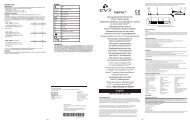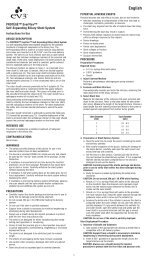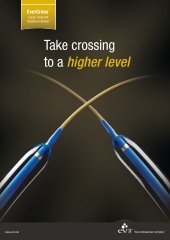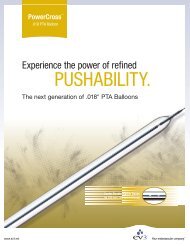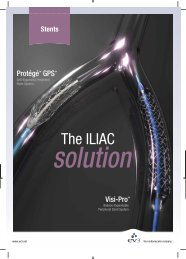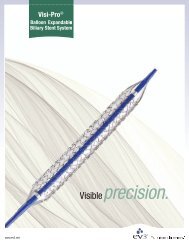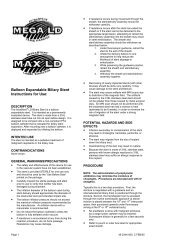Rebar Micro Catheter - eV3
Rebar Micro Catheter - eV3
Rebar Micro Catheter - eV3
Create successful ePaper yourself
Turn your PDF publications into a flip-book with our unique Google optimized e-Paper software.
English Pg. 2<br />
WARNINGS<br />
Infusion pressure with this device should not exceed pressure as specified in the package insert. Excess<br />
pressure may result in catheter rupture, which may result in patient injury.<br />
If flow through the micro catheter becomes restricted, do not attempt to clear the device by high pressure<br />
infusion. Either remove the micro catheter to determine the cause of the obstruction or replace it with a new<br />
micro catheter. Excessive pressure may cause catheter rupture, which may result in patient injury.<br />
Never advance or withdraw an intraluminal device against resistance until the cause of the resistance is<br />
determined by fluoroscopy. Excessive force against resistance may result in damage to the device or vessel<br />
perforation.<br />
PRECAUTIONS<br />
Prior to use, carefully examine the <strong>Rebar</strong> <strong>Micro</strong> <strong>Catheter</strong> and its packaging to verify that it has not been<br />
damaged during shipment.<br />
Embolic agents must be used in accordance with manufacturer’s instructions.<br />
Prior to use, all accessory devices and agents should be fully prepared according to the manufacturer’s<br />
instructions.<br />
BLANK<br />
Always monitor infusion rates when using this micro catheter.<br />
The micro catheter has a lubricious hydrophilic coating on the outside of the catheter. It must be kept hydrated<br />
in order to be lubricious. This can be accomplished by attaching a Y-connector to a continuous saline drip.<br />
When injecting contrast for angiography, ensure that the catheter is not kinked or occluded.<br />
When the infusion catheter is in the body, it should be manipulated only under fluoroscopy. Do not attempt to<br />
move the catheter without observing the resultant tip response.<br />
Because the <strong>Rebar</strong> may be easily advanced into narrow, selective vasculature, repeatedly verify (for example by<br />
slightly withdrawing the catheter) that the <strong>Rebar</strong> has not been advanced so far as to interfere with its removal.<br />
STORAGE<br />
This device should be stored in a dry place at between 50°F (10°C) and 90°F (32°C).<br />
DIRECTIONS FOR USE<br />
NOTE: See package insert for <strong>Rebar</strong> functional characteristics.<br />
1. Place the appropriate guide catheter following recommended procedures. Connect a one-way stop-cock<br />
to the guide catheter to prevent backflow of blood during insertion of catheter. Connect a hemostatic side<br />
arm adapter one way stop-cock to allow for insertion of catheter and to continuously flush the guide<br />
catheter with saline.<br />
NOTE: It is recommended that a guide catheter with a minimum internal diameter of 0.053” be<br />
used with the <strong>Rebar</strong> <strong>Micro</strong> <strong>Catheter</strong>.<br />
2. Gently remove the packaging coil for the <strong>Rebar</strong> <strong>Micro</strong> <strong>Catheter</strong> from the pouch.<br />
3. Flush the coil with heparinized saline through the female luer attached to the coil.<br />
4. Flush the ID of the catheter with heparinized saline by attaching a saline filled syringe to the catheter hub.<br />
5. Remove the appropriate steerable guidewire from its packaging and inspect for damage. Follow<br />
manufacturer’s instructions for preparing and using the guidewire.<br />
6. Carefully insert guidewire into the hub of the <strong>Rebar</strong> <strong>Micro</strong> <strong>Catheter</strong> and advance into the catheter lumen.<br />
7. Remove the micro catheter by removing the hub from the clip and gently pulling on the hub.<br />
8. Inspect the catheter prior to use to verify that it is undamaged. Retain the packaging coil for storage of the<br />
catheter when it is not in use during the procedure.<br />
9. Close the one-way stop-cock.



